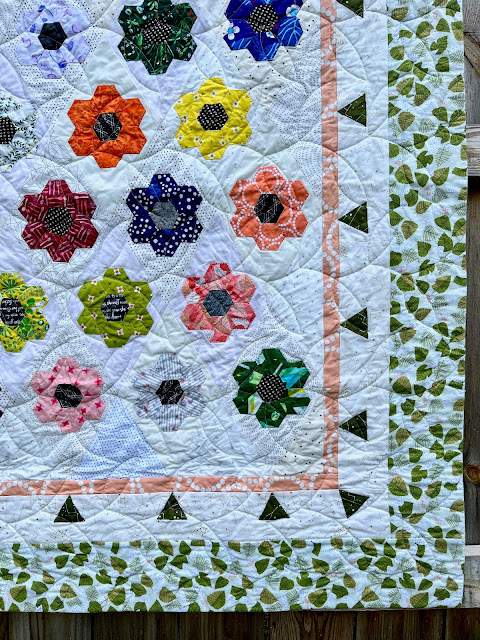The Kingfisher Quilt began with a stitch-along co-hosted by Rachel of Stitched in Color in 2018. I've read Rachel's blog for many years, and this quilt design caught my eye because it combines English paper piecing (EPP) with traditional piecing in a nontraditional layout. I already had hexagon templates from an earlier EPP project, and I enjoy having some handwork and a portable project, so I decided to join in.
Making hexagon flowers -- or any EPP motif -- takes a fair amount of time, so it's helpful to use fabric that you really enjoy looking at and sewing with. I chose to make all my flowers out of Lizzy House prints that I'd collected, and I put a black or dark gray center in each one for some consistency. I tried not to double up on the Lizzy prints, but I think that happened anyway because I didn't have enough to choose from that were suitable for this project. I don't think the duplicates are noticeable in the finished quilt, though.
I took photos of the flowers as I finished them in batches, so I know that it took me three months (June to August 2018) to make all 46 flowers. I'm not sure what happened after that -- I must have gotten sidetracked by other, time-sensitive projects because I didn't start appliqueing the flowers onto their background diamonds until May 2019. I used a machine blanket stitch in coordinating thread to stitch each flower onto its background, tackling a few in the evening after work for a few weeks. The background is a mix of low-volume backgrounds -- one of my favorite ways to do a background. I have a lot of low-volumes in my stash because they're easy to buy on a whim, with no color-matching required and no need to have a particular project in mind, given their versatility. I think mixing them up is much more interesting than using just a solid background fabric, so when it works for a quilt pattern, this is what I like to do. (Note: Many of these background fabrics also appear in my Flowering Snowball Quilt, which made good use of the scraps and leftovers from this quilt!)
The peach Pearl Bracelets, green leaf and green and ivory constellation prints are all also by Lizzy House. I found the green leaf print in an Etsy shop by pure luck and bought a lot. It turns out I should have bought more because there wasn't enough to do the whole back of this quilt. So I added in the ivory constellation print to make up the difference. I decided to use a facing instead of a traditional binding on this to keep the front edge visually clean. I plan to hang it for display instead of use it, so the facing will hold up fine.
As for the quilting, it's a story in itself. Deciding on the right quilting for this project has been a challenge from the start. With the diamonds and the appliques and the borders -- I couldn't make up my mind what would look best, and I didn't see a lot of finished quilts that inspired me in terms of quilting. I decided to just quilt straight lines horizontally on my domestic machine, but I asked a friend with a longarm to baste it for me because it's too big for me to do it easily myself. So I had a basted quilt waiting ... and waiting to be quilted, and I just never felt like I wanted to get started on it. It sat for an embarrassingly long time before I decided to remove the basting stitches and send it to a local longarmer for an edge-to-edge design, just to get it done. Great -- progress, right?
I chose a simple geometric design and it was quilted. I picked it up and, well, was disappointed. The scale of the pantograph was really large, there was lots of empty/unquilted space, and you couldn't even see the design since it was so big. The longarmer agreed that it was quite large and offered to quilt it again for me if I would rip out the quilting. So I thought about it for a few days and decided that I would never be totally happy if I left it how it was. I sat at my dining table in the evenings for about a week watching a couple of shows on my iPad and ripping out the longarm quilting. The bright spot is that, if you have to rip out longarm stitches, this was probably the best design for it -- not dense and straight lines.
I returned the quilt top, batting and backing to the longarmer, and we agreed on a different design -- the same one that Rachel, the stitch-along co-host, had used on her quilt, in fact. It's still a little large and spread out for my taste, but I like it much better than the first time around. I think this quilt was just destined to be a challenge! And now I know to consider the quilting scale upfront.






